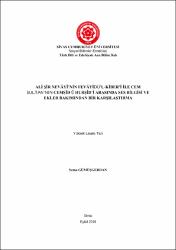| dc.contributor.advisor | Yücel, Bilal | |
| dc.contributor.author | Gümüşgerdan, Sema | |
| dc.date.accessioned | 2020-02-05T05:30:15Z | |
| dc.date.available | 2020-02-05T05:30:15Z | |
| dc.date.issued | 2019 | tr |
| dc.date.submitted | 2019-09-05 | |
| dc.identifier.other | XV, 221 sayfa | |
| dc.identifier.uri | https://hdl.handle.net/20.500.12418/12208 | |
| dc.description.abstract | Bu çalışma, Türk dilinin XV. yüzyıldaki biri doğu (Çağatay) diğeri güneybatı (Oğuz) koluna ait iki eserin ses bilgisi ve ekler bakımından incelenerek karşılaştırılmasını konu edinmektedir. Çağatay Türkçesini temsilen Ali Şir Nevâyî’nin dördüncü divanı olarak bilinen Fevāyidü’l-Kiber, Eski Anadolu Türkçesini temsilenise Cem Sultan’ın Cemşïd ü Hurşïd adlı eseri kullanılmıştır.
Çalışma; Ön Söz, Giriş ve Sonuç bölümleri dışında1. Ses Bilgisi, 2. Ekler ve 3.Ekler Tablosu olmak üzere üç ana bölümden meydana gelmektedir.
Ses bilgisi ve ekler bakımından incelenen her iki eserin de XV. yüzyılda kendi kolunun karakteristik ses ve şekil özelliklerini taşıdığı görülmektedir.
Fevāyidü’l-Kiber; Çağatay Türkçesinin belirleyici özelliklerinden iki heceli kelimelerin ilk hecesinde gerileyici; iki heceli kelimelerin ikinci hecesinde ilerleyici ünlü benzeşmesiyle meydana gelen yuvarlaklaşmaya, Arapça ve Farsça asıllı kelimelerde görülen ek uyumsuzluğuna, ön seste tonsuz ünsüzlerin hâkim olmasına, Türk dilinin tarihinde önemli bir ses olayı olarak kabul edilen “bar, bar-, bir-” kelimelerinde görülen ön seste b- ünsüzünün kullanılmasına, yardımcı fiil olan bol- ve ol- biçimlerinin birlikte kullanılmasına, ek başında ünsüz uyumuna bağlı olarak G-sesinin bulunmasına ve kimi kelimelerde son seste -Gsesinin kullanılmasına, p ˃f değişmesine, zamir n’sinin genellikle kullanılmayışına, kendine has fiil çekimleri ve karmaşık fiillerin kullanımına şahitlik etmektedir.
Eski Anadolu Türkçesiyle oluşturulan Cemşïd ü Hurşïd de bulunduğu yüzyılın özelliklerini bünyesinde taşımaktadır. Eser, Eski Anadolu Türkçesinin belirleyici özelliklerinden olan kelime tabanları ve eklerdeki yuvarlaklaşmaya, bünyesinde ince sıradan ünlü barındıran kelimelerde k- ve t- ünsüzlerinin ön seste tonlulaşarak g- ve d- seslerine dönüşmesine, Çağatay Türkçesinin aksine “var, var-, vir-”kelimelerinde ön seste v-‘nin kullanılmasına, yine bol- yardımcı fiilinin ol- biçiminde kullanılmasına, zamir n’sinin kullanılmasına, Çağatay Türkçesinin aksine kimi eklerde görülen ek başı G- ünsüzünün olmayışına ve çok heceli kelime tabanlarında Çağatay Türkçesinin aksine son seste -G sesinin kullanılmayışına tanıklık etmektedir. | tr |
| dc.description.abstract | This study aims to investigate the Turkish language XV. One of the twentieth century is about the comparison of two works belonging to the east (Chagatay) and the southwest (Oğuz) arc in terms of sound information and appendices. Fevāyidü’l-Kiber’i, known as the fourth divan of Ali Şir Nevâyî, representing Chagatay Turkish, and Cemşïd ü Hurşïd, Cem Sultan, representing Old Anatolian Turkic.
This work is composed of three main part, except preface introduction and conclusion, 1. Phonetics 2. Appendixes and 3. Forms.
Both works studied in terms of sound information and annexes are belonging to XV. It appears that the Turkic people of the twentieth century carry the characteristic sound and figure features.
Bedāyiʿuʿl-Vasaṭʾ mediocre; The decisive features of Chagatay’s are regressivein the first sentence of two syllable words; in the second half of the two-syllable words; the rounding that takes place in a prosperous analogy, the affix disagreement found in the Arabic and Persian stock words; the dominance of the unvoiced consonants in the front sound; the usage of the front sound b- seen in the words “bar, bar-, bir-” which is accepted as on important sound event; the helping verb of bol- is prase and the helping verb of ol- in poem; being the sound G- at the beginning of the affix depending on the vowel disagreement and the usage of the sound -G as a lost of soma words; the changing of p>f; the pronominal n’s disuse in general; typical cengugations and the usage of complex verbs.
the Cemşïd ü Hurşïd, formed by the Old Anatolian Turkic, also contains the characteristics of the century. Rounded adjuncts in words which include vovels such as k- and t-consanants g- and d- are used in front of the words. In contrast to the Chagatay Turkish in the words lise “var, var- vir-” the first phono includes v-. the helping verb of bol- is used as ol-. In Çhagatay Turkish adjuncts G- was used before the adjunct and also in the last phono. Of more syllable words -G was used. It is seen that this used consanant was not Old Anatolian Turkic. | tr |
| dc.language.iso | tur | tr |
| dc.publisher | Sivas Cumhuriyet Üniversitesi - Sosyal Bilimler Enstitüsü | tr |
| dc.rights | info:eu-repo/semantics/openAccess | tr |
| dc.subject | Ali Şir Nevâyî | tr |
| dc.subject | Cem Sultan | tr |
| dc.subject | Çağatay Türkçesi | tr |
| dc.subject | Eski Anadolu Türkçesi | tr |
| dc.subject | Ses Bilgisi | tr |
| dc.subject | Ekler | tr |
| dc.title | Ali Şir Nevâyî’nin Fevāyidü’l-Kiber’i İle Cem Sultan’nın Cemşîd Ü Hurşîd’i Arasında Ses Bilgisi ve Ekler Bakımından Bir Karşılaştırma | tr |
| dc.type | masterThesis | tr |
| dc.contributor.department | Sosyal Bilimler Enstitüsü | tr |
| dc.relation.publicationcategory | Tez | tr |















